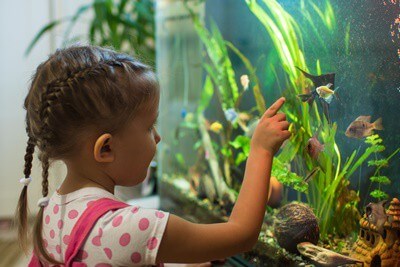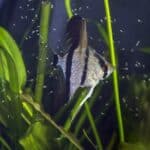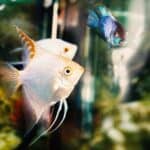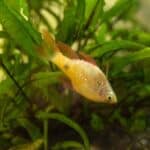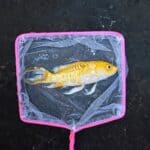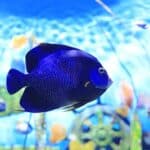Breeding angelfish can be a great way to keep up the population of your tank. However, while the adults are considered hardy, angelfish fry can be very delicate. Your first collection of baby angelfish might die off or get eaten by tank mates. They could also manifest signs of illness and stress, stunting their growth and overall lifespan.
The key to keeping angelfish fry alive is to maintain a very strict living environment. New owners mistakenly get a too-small tank or even a too-large tank for their angelfish fry. You may also imbalance the pH, dKH, and temperature range of the tank. If you forget to change the water weekly, fail to use a sponge filter, or don’t add aquarium lighting, the fry will suffer. Angelfish can survive in a community tank as fry, but only with the right tank mates.
The fry should be given a diet that transitions from meat to dry food as they age. Their tank should not have reflective glass or be exposed on all sides. This can increase stress levels, and even cause the parents to eat the fry. Let’s look at the most common mistakes and how they can be avoided.
How To Keep Angelfish Fry Alive
It’s easy for new owners to fail in the initial few tries. If done incorrectly, you may find the angelfish not growing or not free-swimming. You may even discover your angelfish fry dying off in large numbers.
Avoid these costly mistakes. That will help improve your fry’s longevity and, thus, their likelihood to grow into healthy adult fish.
Avoid Improper Angelfish Fry Tank Setup
The tank size you choose will determine how your fish grow, interact with each other, and even how they digest their food. A tank that’s too small will result in overcrowding and dirtier water. It may even cause the chemical balance of the aquarium to spiral out of control.
On the flip side, a tank that’s too large will cause stress. They will be frightened by the wide expanse of space. This fear may cause them to stop eating and, therefore, stop growing. To avoid both problems, choose a tank that fits your angels’ current size. As they reach their full 6-12 inches of length, you can upgrade them to a larger aquarium.
Here’s the ideal sizing, based on body size and the number of angelfish fry.
| Body Size | Number of Fry | Tank size |
| Nickel-sized | 1 | 1 gallon |
| Quarter-sized | 1 | 2 gallons |
| Silver dollar-sized | 1 | 3 gallons |
Avoid Incorrect Water Temperature
Angelfish fry will die off when placed in water that’s too hot or cold. They thrive best in water that’s between 80 to 84.5 degrees Fahrenheit, or 26 to 29 degrees Celsius.
After all, wild angelfish live in the tropical rivers of South America or the balmy reefs throughout the Pacific Ocean. Temperatures in the low to mid-80s are commonplace in these locales.
You should consistently maintain these temperatures, because angelfish are ectotherms. Ectotherms are cold-blooded organisms that rely on their environment to preserve warmth. As such, they’re sensitive to fluctuations in outside temperature. If your tank wildly swings up and down by 5 degrees, your angelfish may grow sick or die anyhow.
As a plus, there are advantages to keeping a consistent temperature. According to the Journal of Thermal Biology, a consistent temperature range can impact your fry’s:
- Metabolism and how much it eats
- Ability to grow
- Swimming speed
- Likelihood to breed in adulthood
Avoid Incorrect Water pH and Hardness
The pH levels of your tank are crucial to angelfish fry. This defines the amount of ammonia and ammonium in your tank.
- Lower pH levels mean higher ammonium concentrations
- High pH levels refer to higher ammonia concentrations
This affects your fry’s ability to regulate its sodium influx and efflux. This is important for preserving the balance of body fluids, which is linked to the growth and survival of your angelfish fry. While adult angelfish can tolerate a broader pH range, the fry cannot. According to the International Journal of Tropical Biology and Conservation, a water pH level between 6 and 8 is recommended.
After that, you need to check the water hardness. This is the amount of dissolved minerals within the water. Hard water contains a lot of minerals, while soft water does not. Water hardness is measured with dKH, which also gauges the carbonate in water. This buffers the acids that are naturally produced from your angelfish’s feces, thus preventing the water pH from changing suddenly.
Maintaining KH levels goes hand in hand with maintaining pH levels. The recommended dKH for your angelfish fry tank is 3 to 8 dKH.
If you place your fry water with incorrect pH and hardness levels, they may bloat and die prematurely. The higher the levels become, the more likely this is. Even if you stay on the low end of the spectrum, sudden changes in the levels may cause undue stress.
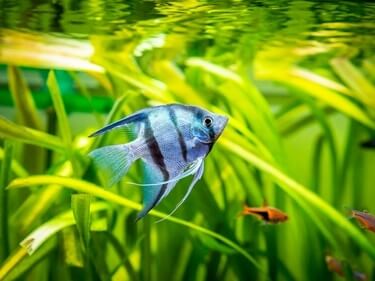
Avoid Infrequent Water Changes
It can be tempting only to change your tank’s water once a month. However, angelfish fry need their water changed at least once a week. Waiting any longer will allow a build-up of:
- Fish waste
- Food waste
- Toxins
- Bacteria
This can dramatically change the chemical balance of the tank. Likewise, it causes the fry to live in filth, which can stunt their growth. That makes it wise to change about 30% during each session. If you’re concerned about shocking your fish, you can change 15% of the water twice a week. This will avoid upsetting your fish, while also properly cleaning out the tank.
Of course, the use of filters will help. These can filter out waste and purify the water on a daily basis. Because fry are more susceptible to bacteria and toxins, however, it’s not enough on its own. Until they reach adulthood, or unless you have a very powerful filter, it’s wise to continue with weekly changes. The more fish you have, the more crucial this will be.
Never Exclude A Sponge Filter
If you’re keeping fry, then it’s important to choose the right tank filter. Active sponge filters work to:
- Maintain the tank’s nitrogen cycle
- Preserve a balanced tank with helpful microorganisms
As mentioned, angelfish fry are sensitive to ammonia and ammonium ion concentrations. This is a typical part of the nitrogen cycle. Therefore, active sponge filters work hand in hand to aid your tank water’s pH levels. They’re easy to clean and can be reused.
As a bonus, sponge filters are well suited to fry tanks. They do not cause much water turbulence, which is a downside for most power filters. Low water flow is preferred by adult angelfish, but fry will be even more vulnerable. They may exhaust themselves in fast-moving currents or even get sucked up by the filter. Sponge filters keep this from happening.
Do Angelfish Fry Need Light?
Angelfish do need light to be healthy and reach their full size. In the wild, they live in shallow reef waters and tropical rivers, where sunlight is a given. If you’re keeping fry, be sure to give them proper exposure to an aquarium light.
This will have a dramatic impact on their circadian rhythm. This is a specific sleep-wake cycle that dictates when your angelfish feels the most energetic or sluggish. Like with all creatures, this cycle is controlled by light, with a 12-hour day and a 12-hour night on average.
If you have live plants in your aquarium, lighting can help these plants flourish. This is beneficial both for the health of your angelfish fry and their tank water quality.
With that in mind, try to mimic the 12-hour day and 12-hour night cycle found in nature. The light should change gradually over time, rather than flicking directly on. Otherwise, your angelfish may be startled by the sudden change.
Ambient light is good for your fry, but only if they are kept in a well-lit room. If you live in a place where the lighting is unreliable, you will need lamps or fixed aquarium lights. That’s especially true if your region fluctuates heavily between sunny and cloudy days.
Can Angelfish Fry Survive In A Community Tank?
Angelfish fry are capable of living and growing in community tanks. The parents will be defensive of the offspring and help safeguard them against other fish. However, this is a more challenging process for new owners. Even with the parents on guard, there are dangers.
Angelfish fry in a community tank are at risk of being predated on by larger fish species. Furthermore, if the larger fish stress out the parents, they are likely to start fights. These may escalate throughout the tank and cause your fry to be injured. In the worst cases, the parents may eat the fry themselves out of stress.
If you want to increase the survival rate of your angelfish fry, consider using a separate tank. They can be removed from the parents as eggs and then raised by you. Alternatively, you can keep the parents and the fry in a separate tank together. If you insist on housing your angelfish fry in a community tank, be sure to:
- Provide hiding spaces that are only accessible by your adult angelfish and the fry.
- Pick tall and compact plants that have long roots, as they will make the angelfish feel secure.
- Feed all of your tank occupants at the same time, so there’s less competition.
- Offer all fish a broader diet, so they feel full and complacent
Most of all, choosing the right tank mates will help limit the risk to your fry. Here are some to consider.
Compatible Species
These are relatively safe fish to house with your fry. They will get along with adults and young angelfish alike, so long as they have enough space and food.
Be sure to introduce them to the tank long before your angelfish start reproducing. If they come later, the sudden arrival of new competition may result in conflict and the death of your fry.
- Certain catfish (corydoras, bushy-nose pleco)
- Tetras (head and tail light, rummy nose, lemon)
- Livebearers (platies, mollies, swordtails)
- Small cichlids (rams, krib’s, keyholes)
- Praecox rainbow fish
- Zebra loaches
- Dwarf gouramis
- Guppies
Species to Avoid
These species are very dangerous to angelfish fry. They’re larger, more likely to start fights, and are known to hunt other fish on an active basis.
- Oscars
- Flowerhorn cichlids
- Jaguar cichlids
- Wolf cichlids
- Convict cichlids
- Jewel cichlids
- Banded cichlids
- Tiger barbs
- Red tail and rainbow sharks
- Bucktooth tetra
- Betta fish
What To Feed Angelfish Fry
With an improper diet, angelfish fry are likely to die, fail to reach adult sizes, or become ill. Likewise, fry require different food, based on their stage in the growth cycle. Feeding them willy-nilly will spell out terrible results.
Do not feed your angelfish fry if they are not free swimming for at least 24 to 48 hours. During this time, fry are still attached to the yolk sac and will use those nutrients for 1 to 2 days. Even if they’re free-swimming, they’re not yet ready.
Here’s what to offer the fry at different points of development. This will keep them full and happy.
- First few weeks of development: Be sure to feed them freshly hatched brine shrimp and micro worms.
- At 3 to 4 weeks of age: The fry can upgrade to crushed fish flakes, fry-starter formula food, micro fish pellets. That can be paired with hatched brine shrimp and micro worms.
- At 4 to 6 weeks of age: Give your little angels freeze-dried food, including bloodworms, brine shrimp, and Mysis shrimp. This can be paired with fish flakes and fish pellets.
During the 3-4 week time period, slowly introduce dry fish food to their diet. Once your angelfish fry are 4 to 6 weeks of age, their digestion is prepared for more dry food than meaty foods.
As you transition them, introduce new foods one at a time. The fry should be accustomed to a new food before you give them another kind. Otherwise, they may bloat, refuse the food, or struggle to digest it.
Can You Overfeed Angelfish Fry?
Fry need to eat more than their parents, since they’re growing, but they can still be overfed. This can lead to bloating, constipation, and swimming issues. Even if the angelfish fry know to reject food when they’re overly full, this can still impact the water quality.
By offering too much food, the rest will drift down into the tank. Here, it will decompose and unbalance the chemical levels. The water quality will then plummet within a few short weeks.
According to the Brazilian Journal of Animal Science, you should only feed angelfish 2 meals a day. This allows them to reach their maximum size, tops up their energy levels, and safeguard them against illness.
Only feed your angels what they can consume in 3-5 minutes. Anything leftover should be removed from the tank. If you find too much has drifted to the bottom, try to clean that area during your next water change. You can also invest in bottom-feeding fish to mitigate any leftovers.
Avoid A Stressful Environment
Stress is one of the biggest dangers to angelfish, but especially fry. They are not only contending with their own stress. They also have to deal with the aggressive and potentially cannibalistic results of stress in their parents.
Because of that, creating a stressful environment is the biggest mistake owners make when raising fry. Even if you’ve gauged the correct water quality and have the diet perfectly balanced, this can catch you off guard.
Angelfish fry (and their parents) are stressed when the factors listed above are poorly maintained. However, they can also be riled up by:
- Mating season and behavior for other fish
- Too much activity outside of their tank
- A lack of decorations
- Fast-flowing currents
- Too much activity from other energetic fish
Are My Angelfish Fry Stressed?
Stress in your fry can lead to many health problems. According to the American Physiological Society, this can include:
- Stunted growth
- Breathing issues
- Poor immune system
- Less activity and energy
- Lack of appetite
These problems can be boiled down to disrupted homeostasis. Homeostasis is the balanced physiological state maintained by an organism’s hormones, organs, and chemicals working together.
An organism that is not in homeostasis is, therefore, not in balance. This can lead to many health issues if the body cannot promptly restore itself to its homeostatic state.
Stressed fry may quickly grow ill and die. At the least, they may never reach their full size or color, and always appear lethargic.
It can be hard to notice when your aquarium is stressed out. Here are the signs you can look for in your fry, so you can rebalance the tank quickly.
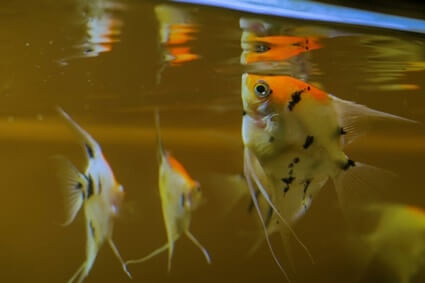
Physical Signs of Stress
These symptoms should be easy to spot in a glance:
- Lackluster or dark coloration, especially if they are supposed to be vibrant or patterned
- Unusual red streaking on fins
- White spots on the body, signaling a parasitic or fungal infection
Behavioral Signs of Stress
These signs require a closer look. Keep an eye on your fry over the course of 1-2 days and see if you detect:
- A loss of appetite
- Hiding for long periods of time
- Heavy breathing, such as gasping for air
- Darting randomly across the tank
- Frantic swimming
- Lack of activity
- Scraping against the bottom of the tank
Will Angelfish Eat Their Own Fry?
A common mistake is placing angelfish parents in with the fry. If you separate them, their chances of survival are higher. With that said, if you do keep them together, it’s a mistake to let the parents get overly agitated.
Angelfish can eat their own fry. In some cases, this is a lack of experience causing the parents to confuse their protective instincts with their aggressive instincts. However, the most common reason is stress from the environment.
Angelfish are far more likely to eat their fry in a community tank. The presence of other tank mates can make them antsy and defensive. In their eagerness to fend off intruders, they may attack their own offspring.
Likewise, a too-small tank will cause the angelfish to defend their territory viciously. Even if other fish aren’t bothering them, their presence will seem like an intrusion. Your angelfish fry may pay the price for that.
Avoiding Stress in Angelfish Adults
The best way to keep both the parents and the fry happy is to build the right environment. With these factors in place, they can remain calm and focus on growing to their full size:
Hiding Places
Just like adults, baby angelfish need places to hide and feel secure. This shouldn’t be a single plant or one decoration, but a full collection. Be sure the tank is large enough to accommodate:
- Driftwood
- Caves
- Rocks
- Plants
Avoid placing things in your tank that are too porous. They may harbor bacteria and fungi growth. Aside from that, if your tank is overcrowded, then you can invest in a larger tank or:
- Set up 1-2 hiding places on opposite sides of the tank, so there’s less need to share
- Set up one large hiding place with several entries or nooks
- Use plants with flowing leaves, so the fish aren’t boxed in, but can still break the line of sight
Move The Tank To Another Location
Fish can indeed see outside of their tank. While the view won’t be great, they can spot movement, shapes, and hear a limited number of sounds.
If your aquarium is placed in the center of the room, consider moving it so that one side is against a wall. This will keep your angelfish from feeling exposed and threatened.
Cover The Sides
If your fry are still stressed, then consider covering two sides of the tank. The level of activity may make them feel exposed. That’s especially true if you don’t have several decorations in the tank. To be safe, try hanging a cloth over either side and only leave the front open.
Place The Tank Up High
If you have pets, then it’s wise to place your tank high up where it can’t be reached. Even the sight of a dog running past, or a cat tapping at the glass, can disturb your fish. By putting it out of reach, the activity, light, and antagonizing behavior of other pets will be limited.
Limit Reflections
Depending on your tank’s design, the glass may reflect the image of the fry back at them. This can make the angels feel overcrowded and threatened. Here, it’s wise to paint the bottom or one side of the tank a dark color to limit how many fish they ‘think’ they’re seeing.
Angelfish Fry Survival Rate
Unfortunately, not all angelfish that hatch from eggs will make it to adulthood. According to the International Journal of Tropical Biology and Conservation, their mortality rate can range from 50% to 66.3%. In this study, the range was dependent on the diet that they consumed. However, your angelfish fry’s survival rate will vary based on many other factors.
By avoiding the mistakes above, you can help your fry grow into healthy adults. Not all of them will reach their full size and age, but you can improve their survival rate.

